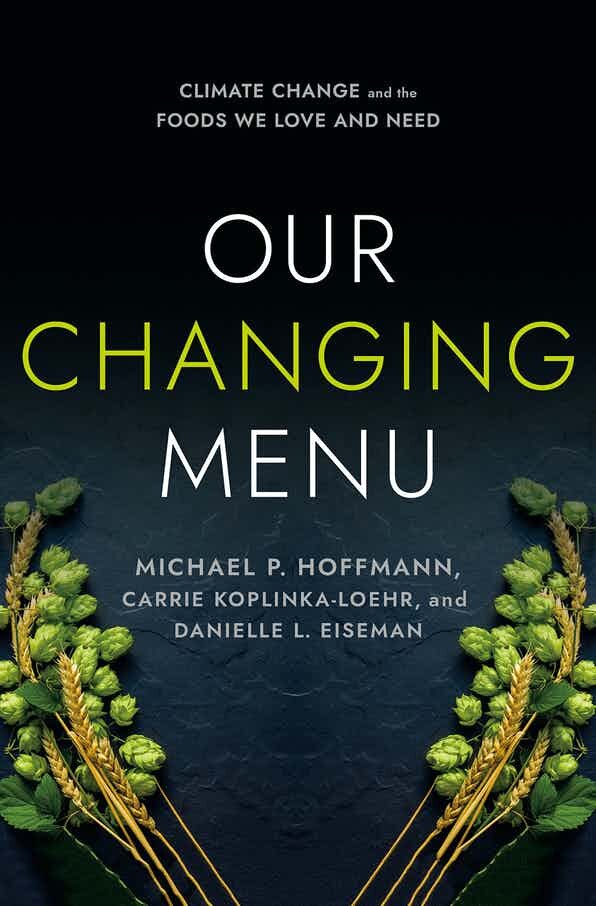Your favorite foods are changing
Olive trees are generally around for the long haul. In the Mediterranean, some trees have been producing olives for more than two thousand years. But higher global temperatures are leading to earlier blooms, which is leading to dramatic plunges in olive oil production.
Our Changing Menu, written by Michael P. Hoffmann, Carrie Koplinka-Loehr, and Danielle L. Eiseman is an excellent exploration of the changes brought by climate change.
This is only one example among many chosen by the authors of Our Changing Menu: Climate Change and the Foods we Love and Need, to illuminate how almost every food we consume is being affected by climate change. Written by climate experts Michael P. Hoffmann, Carrie Koplinka-Loehr, and Danielle L. Eiseman, the book describes the many ways foods we take for granted are at risk.
Take a cup of coffee. The authors detail how coffee thrives in a very specific set of temperatures—between 64 and 70 degrees Fahrenheit. As temperatures continue to rise, coffee yields are taking a hit. In Tanzania, for example, an increase in nighttime temperatures means yields are plunging and will continue to.
But the authors don’t just underscore the problems. They position this book as a resource to not only understand how the food landscape is changing, but prepare readers “for action.” The book is “a way forward,” they write, a tool intended to spur a meaningful response to global warming from scientists, farmers, and consumers.
Toward that end, the book includes a number of different ways people are addressing climate change. Farmers are growing coffee in different environments, for instance, and planting buffer trees to protect against higher temperatures. Growers are planting cover crops to maintain soil health, diversifying the crops they plant, and finding ways to use less energy. Scientists are working on engineering more resilient crops that can withstand higher temperatures and drought.
“If consumers plus those in the business of food join forces and raise their voices it could be transformative.”
But industry-specific changes aren’t enough to save the foods we love, write the authors. They emphasize the importance of unified action. It will take everyone, “consumers...producers, chefs, restaurateurs, retailers, manufacturers,” to truly transform and save the food landscape.
In the wake of critical reports like the IPCC’s 2021 report on climate change, feelings of so-called eco-anxiety are rising. More than two-thirds of Americans reported feeling somewhat or extremely anxious about climate change in 2020 according to the American Psychiatry Association.
In the wake of alarming information, it is easy to feel paralyzed by indecision or apathy: will taking action actually do something? I believe so, and that is why I was particularly drawn to the seven action items they say individuals can take to promote a more climate-forward food world.
Talking about global warming with friends and family can help activate broader change. (Photo by Nathan Dumlao on Unsplash)
Become climate literate. By studying the changes that are occurring and scientifically credible information about the climate crisis, we are in a better position to make informed climate conscious decisions and more comfortable talking about climate change with others.
Start talking about climate change. Research suggests that talking to your friends and family about climate change leads to greater engagement all around—so bring it up with people! Make talking about climate change “a social norm,”get it on people’s minds. Change begins with awareness.
Switch to a plant-based diet. Americans eat three times more meat than the global average. If Americans switched to a fully plant-based diet, food-related emissions in this country would be reduced by up to 73 percent, say the writers. “The greatest impact we can have with our food choices is to transition to meals that are more plant-based.”
Reduce food waste. Buy only what you need, store fruits and vegetables properly for maximum freshness, and get creative in the kitchen and use leftovers and old ingredients before they spoil. “If food waste were a country it would be the third largest greenhouse gas emitter globally.”
Consider your entire carbon footprint. Food is not the only way to make meaningful changes for the climate, of course. Consider driving and flying less and reducing material consumption overall.
Celebrate the people who supply our food. Think about the hands that have picked your produce, the people who package your food, and the drivers who deliver it. Buy local if possible, and consider joining a Community Supported Agriculture (CSA) program. The authors advise us to: “Consider pausing before your next meal to appreciate where your food comes from.” The thinking is that learning how food gets to you is critical to understanding the carbon footprint of the entire food supply chain.
Be an activist. Use your knowledge to advocate for change locally, nationally, and globally, within government, homes, and businesses.
Most of this made sense to me—though I ended up wishing there was more an individual can do. (Here, for instance, are a few other options.) It does help that the authors have built a “living version” of the book in the form of a website readers can use to access the most up-to-date information about our food landscape.
In the end, Our Changing Menu is an excellent introduction to the science behind our changing planet and the problems presented by climate change. Where the book is most successful is the way it takes a massive problem, and breaks it down into solutions that can lead to meaningful action.
“It is now your turn,” they write.“Help build momentum and inspire others to join. Be courageous.” I’m all in. What other choice do we have?
Lizzie Kalvesmaki is a Stone Pier Press News Fellow based out of Northampton, MA.











